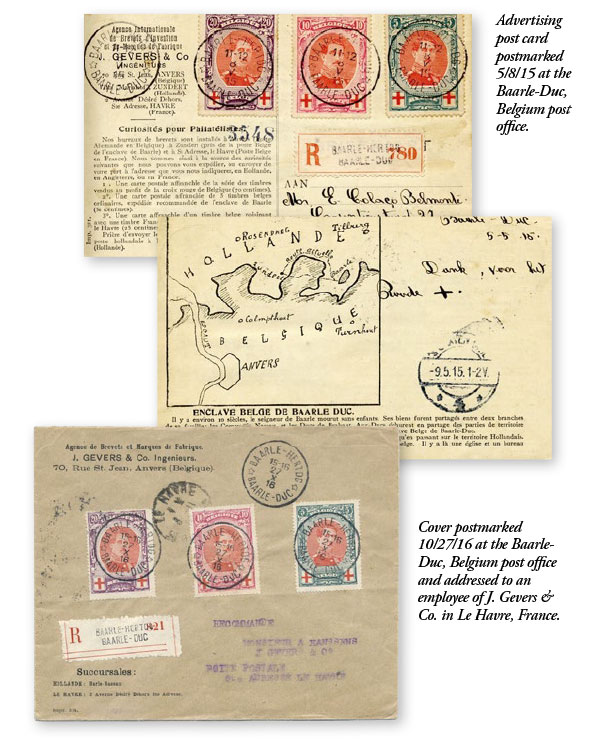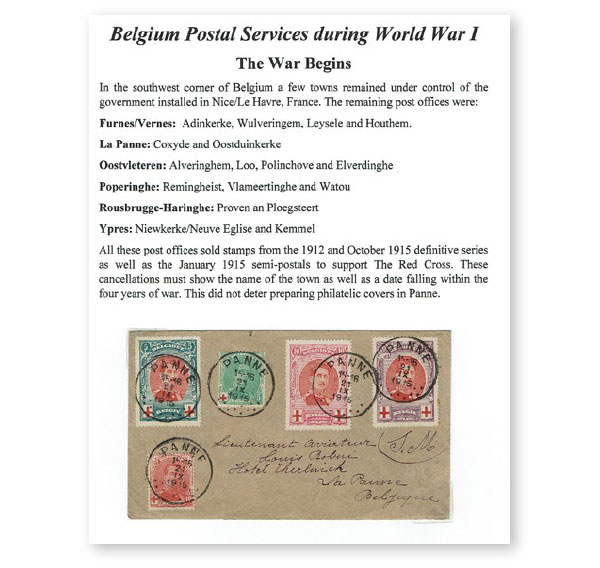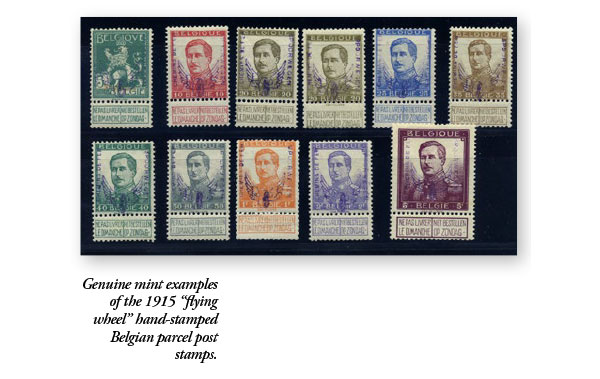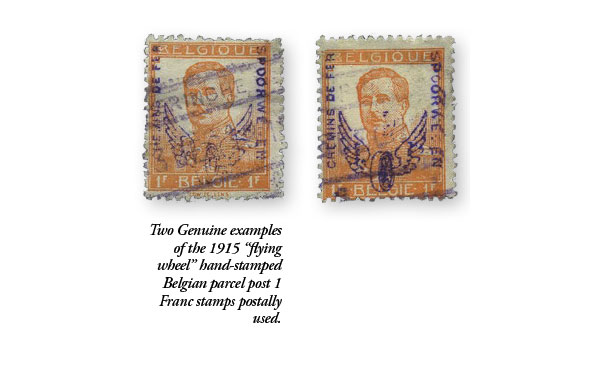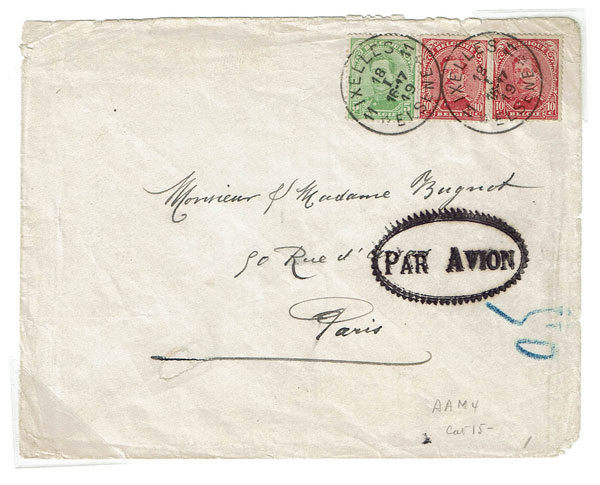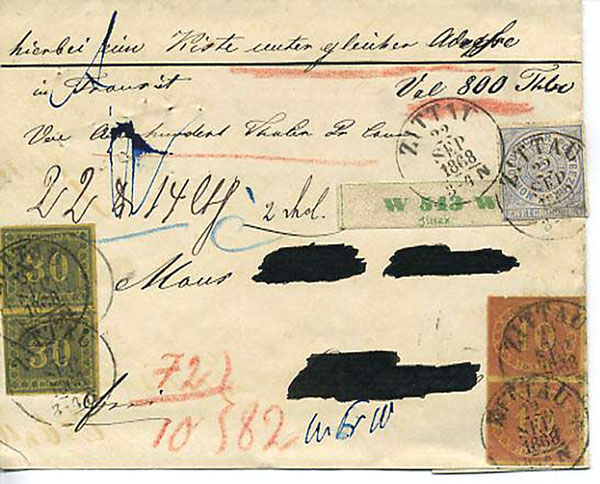THE FAMILY BASIS OF MY COLLECTION
Stamp collecting in our family began in Germany two generations before I was born. Both my grandfathers, who were born in Germany, were collectors. My maternal grandfather, Edward Merton, had a nice collection of French stamps. But it was my paternal grandfather, Edward H. de Bary, who collected more extensively. Before the turn of the century he moved to Antwerp, Belgium which was becoming a financial center. He was married in 1903 and my father, Edmond T. de Bary, was born. Just before WWI my grandfather went into business with his uncle, H. Albert de Bary. Either H. Albert or someone close to him appears to have been a stamp collector. In a collection of covers purchased on eBay, I was amazed to find a paper band that had gone around a magazine or newspaper addressed to none other than H. Albert de Bary. Affixed to it was an overprinted German 5 pfennig stamp used in Belgium during the German occupation. To what extent my grandfather collected at that point is unclear.

My grandfather returned to Germany in 1944. After 1945 he helped us keep up the German collection by sending us packages with the new German stamp issues. On the inside of the package he put mint examples and on the outside he affixed duplicates for the postage, so we got mint and used examples of the same stamps simultaneously. The post horn issue is an example of some of the better sets we got in that way. When my father went to a retirement home, I bought his collection. The collection I got from him was 10 volumes. My core collection now comes to 60 volumes, plus misc. stock books, etc., totaling 91 volumes. The strongest collections are Belgium and Germany, but there are also French, Swedish, Dutch, British, U.S. and some other country collections. Some of the stamps and covers trace back to my grandfathers, some to my father and some I’ve acquired myself. I’ll always be grateful to my fore bearers for amassing a fine basis on which to build my own collection. And I can truly say I never met a stamp I didn’t like!
One Christmas one of the presents from my father was two large Schaubek albums, containing a few stamps. Along with them were some envelopes of loose stamps that I could put into the albums. That was my first collection. After WWII my mother was very anxious to leave Europe, fearing the Russians as much as she had feared the Nazis before. So, we applied to emigrate to the United States as citizens without a state. We were finally able to come in January 1948 and became U.S. citizens.
After the end of the WWI my grandfather went to The Hague and had his own financial business. He helped arrange to move goods to Germany to help alleviate the widespread hunger in the population. By 1923 hyperinflation prevailed in Germany and it was so bad that people would rush out to buy loaves of bread at noon because the same commodity would cost much more by 6 PM that night. At this time my grandfather definitely collected stamps. He saved both stamps and covers. His work included correspondence with the banks, and so he was able to set aside a number of very nice German and Danzig inflation covers from them. Today one encounters fake inflation covers but those from my grandfather are certainly the real thing. Also, with part of the money he made my grandfather bought good collectors’ stamps at auctions in Amsterdam. He did this as a way of saving money without putting it in the bank. He knew stamps pretty well, judging by what he bought.
In the early 1930s my grandfather got permission to go back to Belgium and he and my father, then in his late teens, established a company called Agalire. This company became the agent for the Lloyd Bremen passenger ship line in Antwerp. My father had already become a knowledgeable stamp collector in his own right by then. He took over work on my grandfather’s collection and continued to expand it during the 1930s. In fact he kept the Belgian stamps up through the end of WWII. Whenever my grandfather and father were apart and had an opportunity to correspond each paid attention to what they put on the envelope thus creating interesting covers. There are some nice covers, like Zeppelin covers, that ultimately came into my collection in this way.
About 1934 my mother, Anne Marie Merton, visited Antwerp from Germany. There she met my father, they fell in love and were married. As Hitler began to rise in power in Germany my parents saw the handwriting on the wall and decided to renounce their German citizenship and remain in Belgium. In 1938, when I was born, my parents were citizens without a state and that made me stateless as well.
In 1939 my grandfather gave his stamp collection to my father as part of his legacy. The French collection from my maternal grandfather also came to my father then, too. As WWII began there was a big split in the family. My grandfather was still a German citizen and thought Hitler was a positive force for Germany. So, my parents and I moved to Brussels and my grandfather remained in Antwerp. I think my father only saw his parents once after that.
"During the war, one of the ways our favorite family activities was working with stamps. I can remember when I was about 5 years old, my mother would soak stamps off covers, place a damp stamp on each of my fingers, and I would cross the room and hand them to my father to place in a drying book."
One Christmas one of the presents from my father was two large Schaubek albums, containing a few stamps. Along with them were some envelopes of loose stamps that I could put into the albums. That was my first collection. After WWII my mother was very anxious to leave Europe, fearing the Russians as much as she had feared the Nazis before. So, we applied to emigrate to the United States as citizens without a state. We were finally able to come in January 1948 and became U.S. citizens.
My grandfather returned to Germany in 1944. After 1945 he helped us keep up the German collection by sending us packages with the new German stamp issues. On the inside of the package he put mint examples and on the outside he affixed duplicates for the postage, so we got mint and used examples of the same stamps simultaneously. The post horn issue is an example of some of the better sets we got in that way. When my father went to a retirement home, I bought his collection. The collection I got from him was 10 volumes. My core collection now comes to 60 volumes, plus misc. stock books, etc., totaling 91 volumes. The strongest collections are Belgium and Germany, but there are also French, Swedish, Dutch, British, U.S. and some other country collections. Some of the stamps and covers trace back to my grandfathers, some to my father and some I’ve acquired myself. I’ll always be grateful to my fore bearers for amassing a fine basis on which to build my own collection. And I can truly say I never met a stamp I didn’t like!In 1939 my grandfather gave his stamp collection to my father as part of his legacy. The French collection from my maternal grandfather also came to my father then, too. As WWII began there was a big split in the family. My grandfather was still a German citizen and thought Hitler was a positive force for Germany. So, my parents and I moved to Brussels and my grandfather remained in Antwerp. I think my father only saw his parents once after that.
HIGHLIGHTS FROM MY COLLECTION
Belgian Government in Exile WWI Covers
Before and during WWI, stamp collecting was a major endeavor, as one can deduce by all the stamps and covers that were prepared for collectors. That was certainly true of the Belgian material during WWI. As the Germans were overrunning Belgium, the Belgian government in exile was established at Le Havre/Nice, France. The King remained in Belgium, though, at La Panne. A Belgian post office was set up at Le Havre/Nice and mail sent from there had Belgian stamps on it. You see a lot of those covers, which are often very reasonably priced. But there are various cancellations, used for different periods of time, which created some scarcer items.
Belgian Government in Exile WWI Covers
One of the interesting side stories of the WWI period centers around J. Gevers & Co. The normal business of the Gevers firm was patents and copyrights for industrial properties in Europe. This firm still exists today. During WWI they couldn’t carry on their normal business so they cast about for other ways to make money. J. Gevers & Co. had offices in Antwerp, Belgium; Le Havre, France; and Zundert, Holland. Capitalizing on this, the company offered philatelic covers and post cards sent from special locations, including Baarle-Duc (Baarle-Hertog). Baarle-Duc was an enclave of some 24 small pieces of land, most of which were inside the border of Holland, completely surrounded by Dutch soil. They had been deeded to Belgium in the Middle Ages. The most important parcel had a train station, a hotel and a post office. In their conquest of Belgium, the Germans left Baarle-Duc alone, because Holland (which was neutral in WWI) would not allow the Germans to cross their territory to get to the enclaves.
Jacques Gevers’ office in Zundert was only 15 miles from Baarle-Duc and crossing the Holland-Belgium border was easy if one had the right documents. So, Gevers made up advertisement post cards giving the history and location of Baarle-Duc and offering to send post cards or covers bearing the 1912 regular issue or the 1915 Red Cross semi-postal Belgian stamps to addressees in Holland, England and France. The Gevers post cards and covers are easy to find today, so the marketing of these “philatelic curiosities” must have been very successful.
There was another part of Belgium that the Germans didn’t conquer. There’s a strip of land along the south-western coast containing about 22 towns, that were never taken by the Germans. They flooded the fields there and held up the German advance. So in the free towns Belgian stamps continued to be used, with the exception of the military mail, which was free. I have an almost complete collection of these town cancels, missing only two of the 22 towns. In all the other towns, the Belgian stamps ceased being used for postage and overprinted German stamps were used. I’ve left that material alone, except for the German stationary decorated with stolen Belgian stamps.
Part of my grandfather’s collection of Belgian stamps that has given me much pleasure recently is the Belgian parcel post flying wheel overprints on the King Albert 1912 “Pellens” issue (named after the designer, Edward Pellens). By 1915 the Belgian authorities were running out of stamps, partially because the Germans stole them and were using them to decorate their stationary (i.e., not using them for postage) and partially because more weren’t being printed. So, in June 1915 they authorized the hand-stamping of small quantities of the 1912 issue with text and a winged wheel, the symbol of the parcel post system of Belgium. These stamps were to be used for parcel post in the Belgian towns not occupied by the Germans. The number of stamps marked in this way ranged from 200 (for the 5 Franc) to 750 (for the 1 Franc). For use, the stamps were affixed to the shipping document, rather than the parcel, and the shipping document and stamp(s) were later retained by the post office as proof of delivery. Later, the cancelled stamps were sometimes sold to collectors. The unused stamps are rare and cancelled ones (postally or CTO) are very rare. Excellent counterfeits exist of all the denominations.
In 1926 my grandfather managed to purchase an almost complete cancelled set (three of the small head denominations are missing). They had been collected on behalf of the Spanish Consul in The Hague, who was in London at the time. He consigned them to auction by an Amsterdam firm, where my grandfather bought them. In the 1940s my father had them authenticated by Rene Berlingin, the top Belgium expert at that time. They were pronounced genuine but were probably favor cancelled rather than postally used.
Much later a series of books on Belgian stamps was being assembled by the Monaco Club. They sent out a circular asking for any information about these stamps so I responded and ended up doing a write-up about them in the appropriate volume of the series. The result was that I’ve had good communication with Monaco club people about these stamps over the years. It’s a unique set.
In the meantime, I kept looking for genuine postally-used examples of these stamps and was only able to find two. I lucked out on both occasions. The first came from a collection of Belgian stamps I obtained from a source in Israel for $20. The collection contained some of the flying wheel overprints that I was sure would all be fakes. Fakes of this issue, unused and cancelled, are common. When the collection came in, it included a cancelled 1 Franc orange, which didn’t look all that nice with a couple of missing perfs, so I tossed the whole lot into a box. The second stamp, another cancelled 1 Franc orange, I bought on eBay for a very nominal price. Finally, I shared my group of winged wheels with Schaubek in Belgium via scans, and he said, “You’d better have the 1 Franc stamps looked at.” So, I sent them to Pierre Kaiser in Brussels for authentication and they both came back as genuine and postally-used. That made my day!
To support my expertizing work for the APS, I’ve collected both the genuine and the fake winged wheel stamps. I’ve studied them very carefully, because in the past the APS had refused to expertize them because they didn’t have sufficient knowledge to do so.
During 1915 a new issue of definitives was put out that was printed partially in Paris and partially in London. On eBay I managed to purchase a very pretty cover with the entire set on it. At the time I didn’t pay any attention to the addressee. Then my cousin came for a visit and when I showed him the cover he immediately remarked “Do you know whom that cover went to? Baron Guillaume was the Belgian Ambassador to France!” So, it’s really a historic cover, plus being a first day cover as well.
On Nov. 11, 1918 WWI ended with the armistice and cessation of hostilities. The negotiations that lead to the eventual Peace Treaty began in Paris in January 1919. The train connection between Brussels and Paris was still very slow, so the King of Belgium requested a military plane be made available for flights between the two cities (at no extra postage charge) to allow him to keep up with the negotiations. There were probably three such flights. The covers were stamped Par Avion and these were Belgium’s first air mail flights.
My German collection includes two volumes of German States stamps and covers. The most memorable item in this group is a cover from Württemberg. My father bought this cover, in Brussels I believe. Württemberg was first an independent city-state, then it entered the North German Confederation, and finally the Confederation was amalgamated into Germany. The cover is franked with pairs of the 10 Groshen rose and 30 Groshen blue, printed on what’s called goatbeaters’ skin, a kind of parchment. Stamps printed on this animal skin paper are very rare in good condition because the paper usually deteriorated badly. But in this case the stamps are exquisite. The only downside for this cover is that it is postmarked just after the Northern Federation took over. It was allowed to use the outmoded stamps for a year or two after the formation of the Federation.
After WWI Germany was forced to give much of the area of East Prussia to newly-formed Poland. Two regions were allowed to hold a plebiscite in 1920 to determine whether they would become part of Poland or remain with Germany. A group of stamps were issued in connection with the plebiscite. One was the German 1 Mark with the overprint Commission/Interallée/Marienwerder. I have three varieties of essay for this issue (all with the overprint in all caps) and they are very rare. They were probably part of my grandfather’s collection. I took them with me to the World Stamp Show in Washington in 2004 and showed them to the German dealer from Dresden, who gasped when he saw them! When my collection is sold it’s likely they’ll go back to Germany.


